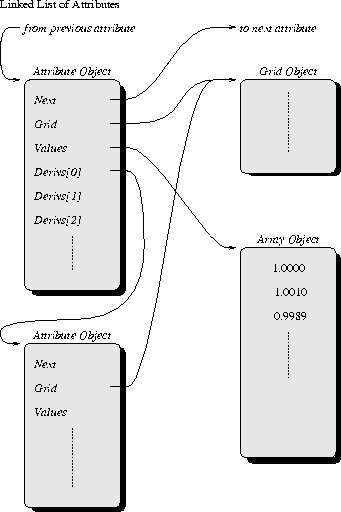The Attribute Class




Next: The Grid Classes
Up: 7.1.1 Architecture
Previous: The Value Definition
The information contained in a value definition object is not enough to
represent a PIF attribute. Attributes additionally have an attribute type
associated with them, and may have an inheritance handle for inheriting
information from other attributes.
However, information is needed in an attribute, that is not pertinent on
PIF but has to be stored in attribute objects too. For example, an
extrapolation constant array see Section 7.1.3 is contained in the
attribute class definition, which is used if the ``constant extrapolation
mode'' is requested from the interpolation routines. In this case the
interpolation routines will use this extrapolation constant, if a point is not
located inside the grid on which interpolation takes place. Furthermore,
a GRS object pointer to the grid object the attribute is
defined on, and an array of pointers to attribute derivatives (which are
attributes themselves) used for interpolation on tensor product grids
see Section 7.1.3 are contained in the attribute class. Fig. 7.3
shows an example of an attribute object which in turn references a grid
object.

Figure: Attribute object referencing a grid object. Note that only members
referencing other objects are drawn. The attribute is contained in a linked
list of attributes. The values of the attribute object are contained in an
array object (in this case a floating point array object). The grid the
attribute is defined on is also referenced by its spatial derivatives, which
are stored as attribute objects too.
During unstructured grid reading, a method for preparing the attribute
containing the element type specification of an unstructured grid is
used. This method reads the ElementType attribute and checks if all
elements are equal (i.e. it is a uniform unstructured grid) or not (i.e. it is
a mixed-element unstructured grid). In the latter case, another method for
reading the next element type from the ElementType attribute is used
then for obtaining the correct grid element type.
For interpolation on attributes, methods for logarithmizing and
delogarithmizing attributes are used, if the quantity to be interpolated has
exponential characteristics. In this case, the attribute is logarithmized
after reading, then the interpolation is performed, and the new (interpolated)
attribute is delogarithmized accordingly.
The higher-order tensor product interpolation needs to calculated the
spatial attribute derivatives prior to interpolation. GRS stores this
derivatives also as attributes, and therefore needs to clone an
attribute holding the derivatives from an already existing one. The cloned
attribute inherits the values of all attribute members, with the exception of
the PIF inheritance handle, but gets a new name assigned which is derived
from the name of the original attribute by appending a sequential unique
number.
The two most important methods used by applications are the one reading an
attribute and the grid it is defined on into memory, and another one
performing the actual interpolation on one point on the attribute.
These two methods are explained in detail in Section 7.1.3.




Next: The Grid Classes
Up: 7.1.1 Architecture
Previous: The Value Definition
Martin Stiftinger
Tue Nov 29 19:41:50 MET 1994




